
Selecting the Right AV Company for Your Event

Introduction to Selecting the Right AV Company
In the dynamic landscape of event planning and execution, the choice of an audio-visual (AV) company is pivotal. A reputable AV company can transform an ordinary event into a memorable experience, leveraging cutting-edge technology to captivate audiences. This section delves into the critical considerations for selecting the right AV partner, emphasizing the importance of expertise, equipment quality, and customer service in the decision-making process. The goal is to equip event organizers with the knowledge to choose an AV company that aligns with their event's unique needs and objectives.
The AV industry encompasses a wide array of services, including sound, lighting, video, and staging, which are integral to the success of any event, from conferences to concerts. Audio-visual companies offer a comprehensive range of solutions, from planning and installation to operation and support. Historically, the evolution of AV technology has transformed how events are conducted, making the selection of an adept AV company more crucial than ever. Understanding the capabilities and services of various audio-visual companies is the first step in identifying a partner that can provide tailored solutions to meet specific event requirements.
Real-World Applications and Current Trends
Choosing the right AV company involves more than just comparing prices. It requires an assessment of the company's ability to innovate and adapt to the latest trends, such as virtual events and immersive audio-visual environments. For instance, companies that have successfully executed hybrid events, combining live and virtual elements, demonstrate the capability to meet contemporary event needs. Examples of successful partnerships with AV companies highlight the transformative impact of employing advanced, AV services and solutions, from enhancing audience engagement to ensuring seamless event execution.
When selecting an AV company, seeking references and case studies can provide invaluable insights into their performance and reliability. Industry awards, certifications, and client testimonials offer tangible evidence of a company's expertise and commitment to quality. Additionally, research published in industry journals or articles that feature notable AV projects can further validate the company's capabilities. Key statistics, such as customer satisfaction rates or the scale of events managed, serve as metrics to gauge potential partners against your event's specific requirements.
Custom AV Solutions for Unique Event Needs
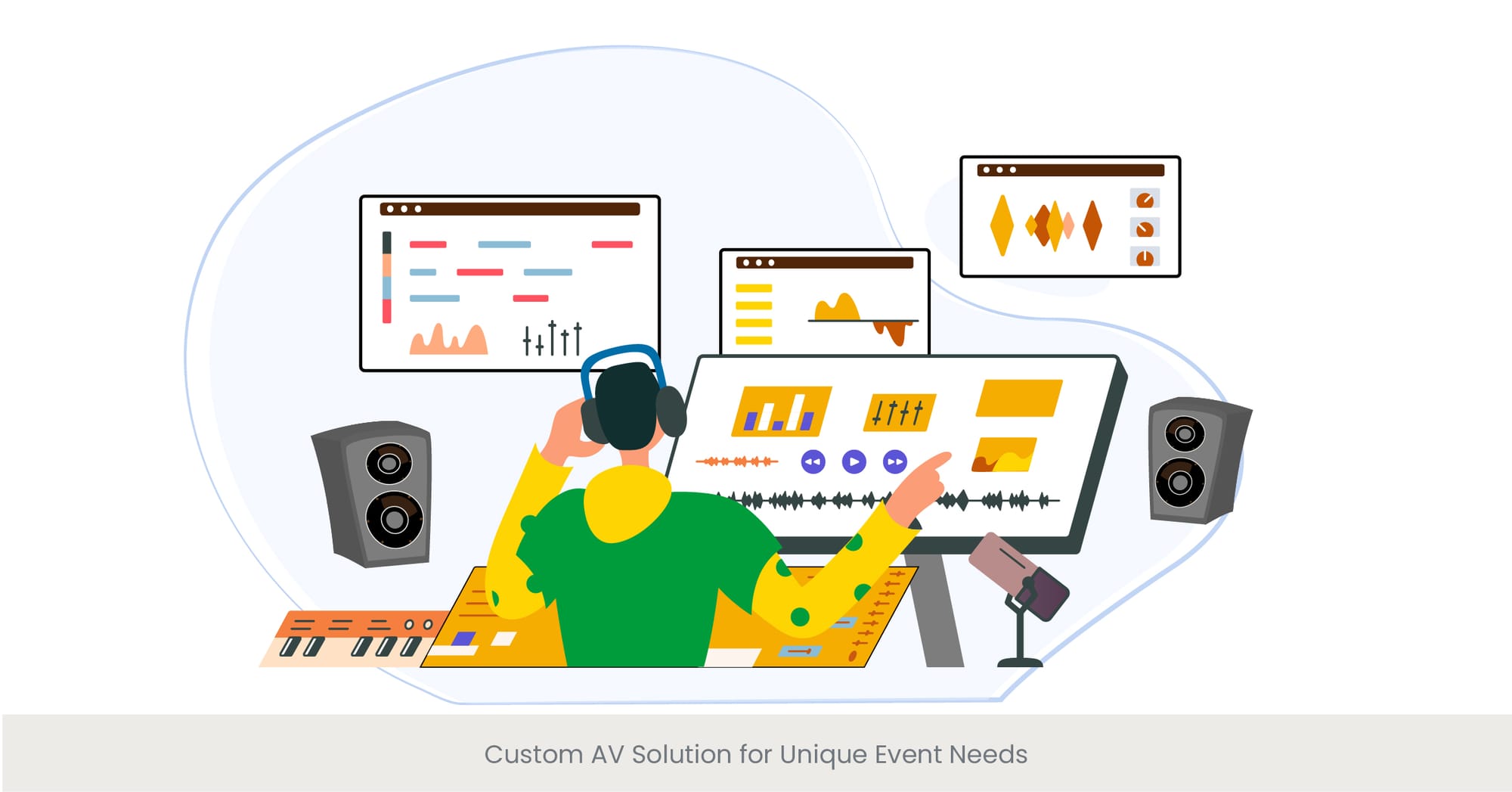
Introduction to Custom AV Solutions
Every event is unique, with its own set of challenges and objectives. Custom AV solutions play a critical role in addressing these specific needs, ensuring that each aspect of audio and video production is tailored to enhance the event's theme, audience engagement, and overall experience. This section explores the significance of custom AV audio video solutions in crafting personalized event environments, from intimate gatherings to grandiose spectacles, highlighting the importance of innovation, customization, and technical precision in achieving event success.
The foundation of a successful event lies in its ability to resonate with the audience, an achievement that often demands bespoke audio-visual solutions. Unlike standard AV packages, custom solutions are designed with a deep understanding of the event's goals, venue specifics, and attendee demographics. Historically, the evolution of AV technology has broadened the possibilities for customization, allowing for immersive environments in conference rooms, interactive installations, and personalized content delivery that captivates and engages attendees in unprecedented ways.
Illustrating Customization through Real-World Examples
The power of custom AV solutions comes to life through real-world examples that showcase their impact on event success. For instance, a corporate conference might employ an array of synchronized LED screens and spatial audio systems to create an immersive presentation space, while a music festival could use custom lighting designs and video mapping to enhance the performance atmosphere. These examples demonstrate how tailored AV solutions can elevate the event experience, ensuring that each moment is impactful, memorable, and aligned with the event's objectives.
The effectiveness of custom AV solutions is further underscored by external references, including case studies and industry analyses. Reports from reputable AV and event industry publications often feature breakthroughs in custom audio-visual implementations, offering insights into the latest trends, technologies, and success metrics. For example, statistics on audience engagement rates or post-event feedback can serve as evidence of the value added by custom AV solutions. Additionally, endorsements from past clients and awards for innovative AV projects can provide tangible proof of a company's ability to deliver exceptional, customized experiences.
The Integration of AV and Digital Technology

Introduction to the Integration of AV and Digital Technology
The integration of audio-visual (AV) and digital technology has revolutionized the event industry, opening new avenues for creativity, engagement, collaboration spaces and efficiency. This fusion enhances the sensory experience of attendees through innovative displays, interactive content, and seamless communication channels. This section delves into the transformative power of integrating AV with digital technologies, emphasizing its role in creating immersive, interactive, and memorable event experiences.
The synergy between AV and digital technology is a testament to the rapid evolution of the event landscape. From digital signage and augmented reality to live event streaming and social media integration, these technologies have become indispensable tools for event organizers. The historical progression from traditional AV setups to fully integrated digital ecosystems illustrates a shift towards more dynamic, personalized, and engaging event formats. Understanding this evolution is crucial for leveraging the full potential of AV and digital technologies in concert.
Real-World Applications and Current Trends
The real-world impact of AV and digital technology integration is evident in a variety of event types and settings. For example, conferences now frequently incorporate mobile apps for real-time audience interaction, while concerts and festivals utilize augmented reality for enhanced viewer experiences. Additionally, the trend towards virtual and hybrid events has underscored the importance of seamless integration, with technologies like virtual reality and live streaming enabling remote participation without sacrificing engagement. These applications not only illustrate the versatility of integrated solutions but also highlight their role in expanding the reach and impact of events.
The benefits of integrating AV and digital technology are supported by numerous studies, industry reports, and case studies. Research findings published in technology and event management journals often highlight the positive effects on attendee engagement, operational efficiency, and overall event success. For instance, statistics on increased attendee interaction rates or case studies detailing successful hybrid event executions provide concrete evidence of the value that integrated solutions bring to the table. Furthermore, testimonials from event organizers and participants offer firsthand insights into the enhanced experiences enabled by the fusion of AV and digital technologies.
The Future of Audio Visual Communication
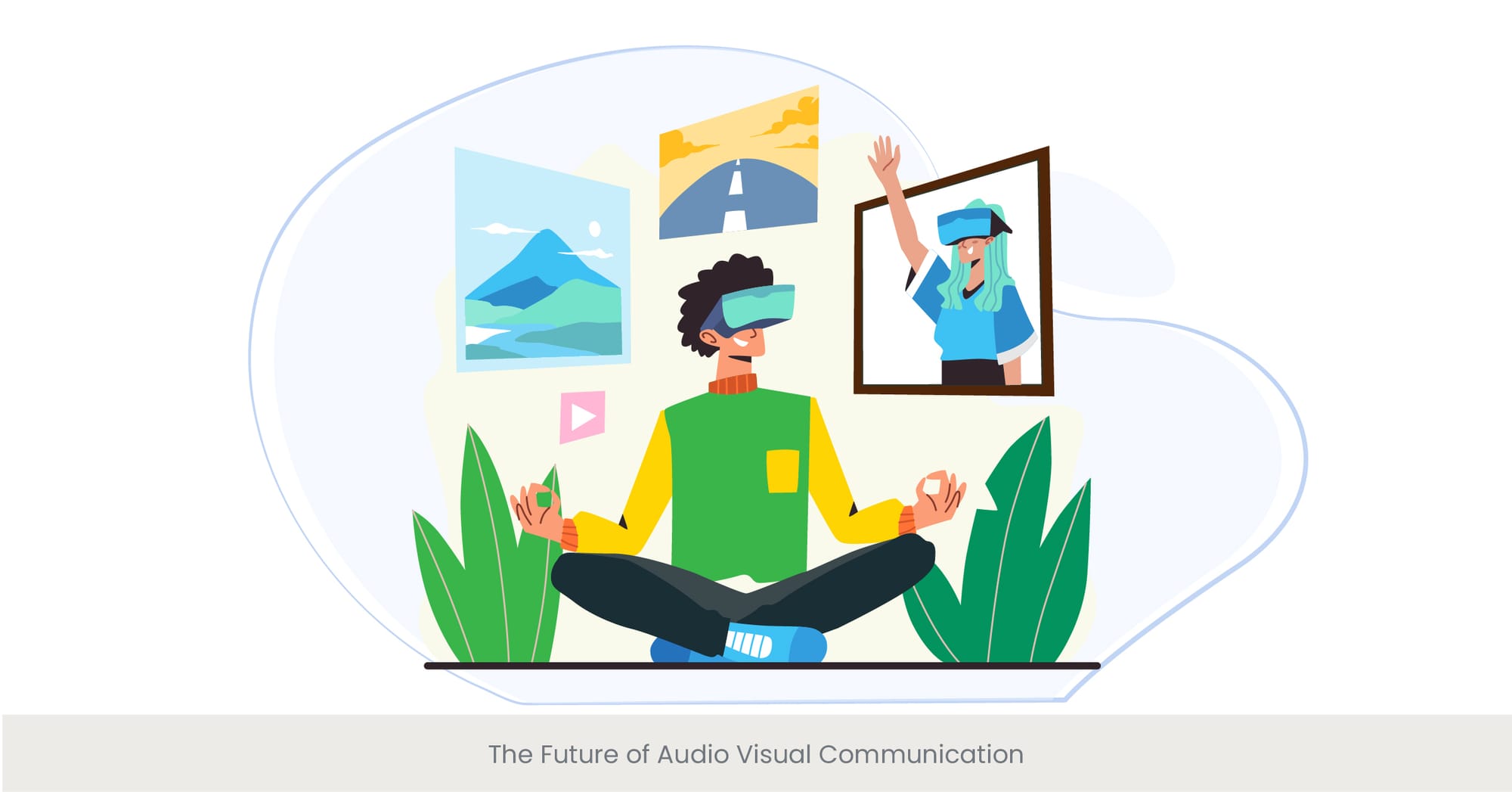
Introduction to the Future of Audio Visual Communication
As we delve into the future of audio-visual (AV) communication, it's clear that emerging technologies and evolving consumer expectations are set to redefine the landscape of interactive media and events. The future promises an era where AV communication is more immersive, interactive, and intuitive, breaking down the barriers between virtual and physical realms. This section explores the anticipated advancements and innovations in AV communication, emphasizing their potential to transform how we connect, engage, and experience media and events.
The trajectory of AV communication has been marked by constant innovation, from the advent of the first audio-visual devices to the integration of digital technologies. As we look forward, the convergence of artificial intelligence, virtual reality, augmented reality, and 5G technology is expected to catalyze profound changes. These technologies promise to enhance the fidelity, interactivity, and accessibility of AV communication, making it a more integral part of daily life and professional environments. Understanding these trends is essential for anticipating how AV communication will evolve in the coming years.
Illustrating the Future with Current Innovations
The future of AV communication is already taking shape through current innovations and pilot projects. For example, augmented reality concerts and virtual reality meetings are offering glimpses into how immersive technologies can create experiences that are more engaging and lifelike. Similarly, AI-driven personalization is making AV content more relevant and engaging, adapting in real-time to the preferences and behaviors of users. These examples not only showcase the potential of emerging technologies but also highlight the ongoing shift towards more personalized, immersive, and interactive forms of communication.
The potential of future AV communication is further validated by research and forecasts from leading technology analysts and industry experts. Reports from tech think tanks and market research firms predict significant growth in the adoption of immersive and interactive technologies, driven by advancements in computing power, global network and infrastructure, and software development. Additionally, academic studies on user engagement and interaction patterns offer valuable insights into how future AV technologies might shape consumer behavior and expectations. By synthesizing these external sources, we can gain a more comprehensive understanding of the trajectory of AV communication and its implications for society and industry.
Balancing Budget and Quality in AV Selection

Introduction to Balancing Budget and Quality
Achieving a balance between budget constraints and the quality of audio-visual (AV) solutions is a critical challenge faced by event organizers and corporations alike. In the world of AV procurement, the quest for cost-effectiveness without compromising on quality or impact is paramount. This section explores strategies for navigating financial considerations while ensuring that AV selections meet the high standards necessary for successful events and presentations, underscoring the importance of value-driven decision-making in the AV industry.
The financial aspect of selecting AV solutions encompasses more than just the upfront cost of equipment and services. It involves a comprehensive assessment of long-term value, including durability, scalability, and the potential return on investment (ROI). Historically, advancements in AV technology have often come with high price tags, posing budgetary challenges for organizations. However, the increasing availability of high-quality, cost-effective solutions has changed the landscape, making it more important than ever to understand the nuances of AV financing and investment.
Real-World Strategies for Budget and Quality
Navigating the balance between budget and quality involves several key strategies, such as prioritizing essential features, exploring rental options for high-cost items, and leveraging competitive bidding among suppliers. Case studies from successful events demonstrate how careful planning and negotiation can lead to high-quality AV outcomes within budgetary constraints. For example, selecting modular and multi-use AV equipment can offer both financial efficiency and adaptability to different event types, showcasing the practical applications of a balanced approach in real-world scenarios.
The effectiveness of budget-conscious AV selection strategies is supported by industry research and financial analyses. Reports from AV industry associations and financial case studies often highlight the correlation between strategic AV investment and event success, offering metrics such as attendee satisfaction scores and ROI. Furthermore, testimonials from event organizers and corporate clients provide anecdotal evidence of the benefits of a balanced approach, including cost savings and enhanced event quality. These external references reinforce the value of informed, strategic decision-making in maximizing both budget and quality in AV selections.
The Role of AV in Audience Engagement

Introduction to the Role of AV in Enhancing Audience Engagement
In today’s event landscape, the role of audio-visual (AV) technology in engaging and captivating audiences cannot be overstated. Whether it’s a corporate conference, live concert, or virtual event, the integration of innovative AV solutions is key to creating memorable experiences that resonate with attendees. This section explores how AV technology serves as a crucial tool in enhancing audience engagement, focusing on the dynamics of sensory stimulation, interactivity, and content delivery.
Effective audience engagement through AV involves more than just visual and auditory stimulation; it requires a strategic approach to content presentation and interactive elements. Historically, the evolution of AV technology has expanded the possibilities for audience interaction, from passive viewing to active participation. Understanding the principles behind these engagement strategies, such as the use of immersive environments, interactive displays, and personalized content, is essential for leveraging AV technology to its full potential.
Illustrating Engagement through Real-World Examples
The impact of AV on audience engagement is vividly illustrated through real-world examples across various types of events. For instance, interactive touchscreens and audience response systems have transformed corporate presentations, allowing for real-time feedback and participation. At music festivals and concerts, advanced lighting designs and video mapping create immersive experiences that elevate the performance. These examples highlight how AV technology can be utilized to engage audiences in innovative and impactful ways.
The significance of AV technology in enhancing audience engagement is further supported by external research and case studies. Studies in event management and technology journals have documented the positive effects of AV on attendee engagement and satisfaction, providing empirical evidence of its value. Additionally, industry reports detailing successful AV implementations offer insights into best practices and emerging trends. By referencing these external sources, we can validate the critical role of AV in creating engaging and memorable event experiences.
Sustainable Practices in AV Production

Introduction to Sustainability in AV Production
Sustainability has become a cornerstone in the planning and execution of events, with audio-visual (AV) production playing a significant role in this eco-conscious shift. The integration of sustainable practices within AV production not only addresses environmental concerns but also aligns with the growing demand for green initiatives in corporate and public events. This section delves into the importance of sustainability in AV production, exploring how eco-friendly solutions can be implemented without compromising on quality or effectiveness.
The journey towards sustainable AV production involves a multifaceted approach, including the use of energy-efficient equipment, recycling programs, and sustainable sourcing of materials. Historically, the event industry has been criticized for its environmental impact, prompting AV companies and event organizers to adopt greener practices. Understanding the environmental footprint of AV activities, from energy consumption to waste production, is crucial in developing strategies that minimize adverse effects on the planet.
Real-World Examples of Sustainable AV
The commitment to sustainability in AV production is exemplified through innovative practices and technologies that reduce environmental impact. For instance, LED lighting and digital signage offer energy-efficient alternatives to traditional AV solutions, significantly lowering power consumption. Additionally, events are increasingly leveraging virtual and hybrid formats to reduce travel-related emissions. These real-world examples not only demonstrate the feasibility of sustainable AV practices but also highlight their potential to enhance event sustainability overall.
The effectiveness of sustainable practices in AV production is reinforced by external research and industry accolades. Environmental studies and reports from sustainable event organizations provide quantitative data on the benefits of green AV initiatives, such as reduced carbon footprints and waste reduction. Furthermore, case studies of award-winning sustainable events showcase the successful integration of eco-friendly AV solutions, offering valuable insights and inspiration for future projects. These external sources affirm the critical role of sustainability in shaping the future of AV production.
Recognition ceremony decks are key in celebrating achievements while keeping the audience’s attention. These presentations often blend visual storytelling with personalized content, showcasing honorees with compelling imagery and seamless transitions. High-quality AV equipment enhances the experience, ensuring every moment of recognition is visually striking and emotionally resonant for attendees.
Want expert guidance for your next project?
Read Our Guide - Navigating the Various Types of Event Presentations
AV Solutions for Outdoor Events
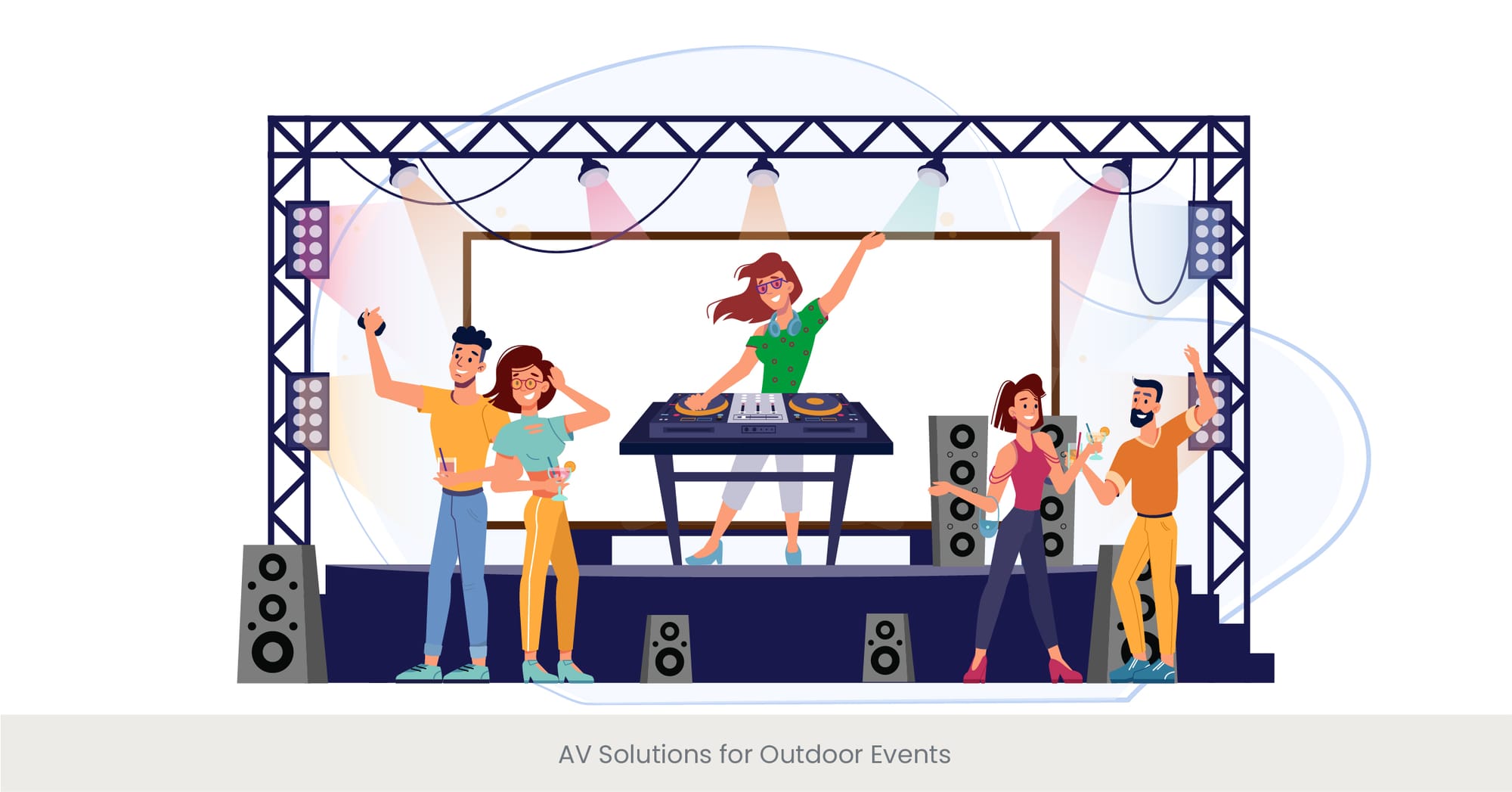
Introduction to AV Solutions for Outdoor Events
Outdoor events present unique challenges and opportunities for audio-visual (AV) production, demanding innovative solutions that adapt to the unpredictability of open-air environments. From concerts in the park to outdoor conferences, the integration of robust and flexible AV technology is crucial for delivering clear sound, vibrant visuals, and seamless presentations under the sky. This section explores the specialized AV solutions designed for outdoor events, highlighting the importance of weather-resistant equipment, spatial acoustics, and visual clarity in creating successful outdoor experiences.
The complexities of outdoor AV production stem from variables such as weather conditions, ambient noise, and spatial layout. Traditional indoor AV setups often fall short in addressing these challenges, necessitating the development of specialized equipment and strategies for outdoor use. Over the years, advancements in AV technology have led to the creation of weatherproof audio systems, high-brightness projectors, and mobile staging solutions, all aimed at overcoming the hurdles of outdoor environments while ensuring audience engagement and satisfaction.
Panel discussion slide presentations play a vital role in structuring conversations and keeping the audience engaged. Well-designed slides highlight key points, support panelists' arguments, and provide visual reinforcement for the audience. Utilizing AV tools like wireless clickers and multimedia integration allows panelists to interact with their slides seamlessly, enhancing the discussion flow.
See how we've helped businesses like yours
View Our Case Study - Diageo India Digital Conference
Illustrating Outdoor AV Solutions with Examples
The effectiveness of tailored AV solutions for outdoor events is best illustrated through case studies and examples. For instance, large-scale outdoor festivals often employ line array speaker systems that offer wide coverage and consistent sound quality, even in expansive spaces. High-definition LED screens, capable of delivering vibrant visuals in bright sunlight, have transformed outdoor movie screenings and live broadcasts. These examples showcase the innovative approaches and technologies that enable AV professionals to meet the unique demands of outdoor events, ensuring memorable experiences for attendees.
The value of specialized AV solutions for outdoor events is supported by industry research and expert commentary. Technical articles in AV publications often detail the specifications and performance of outdoor AV equipment, providing guidelines for optimal setup and operation. Additionally, testimonials from event organizers and attendees offer real-world insights into the transformative impact of effective, AV setup and production on outdoor event success. By referencing these external sources, we can further validate the importance of selecting the right AV solutions to address the unique challenges of outdoor environments.
Navigating Challenges in AV Production
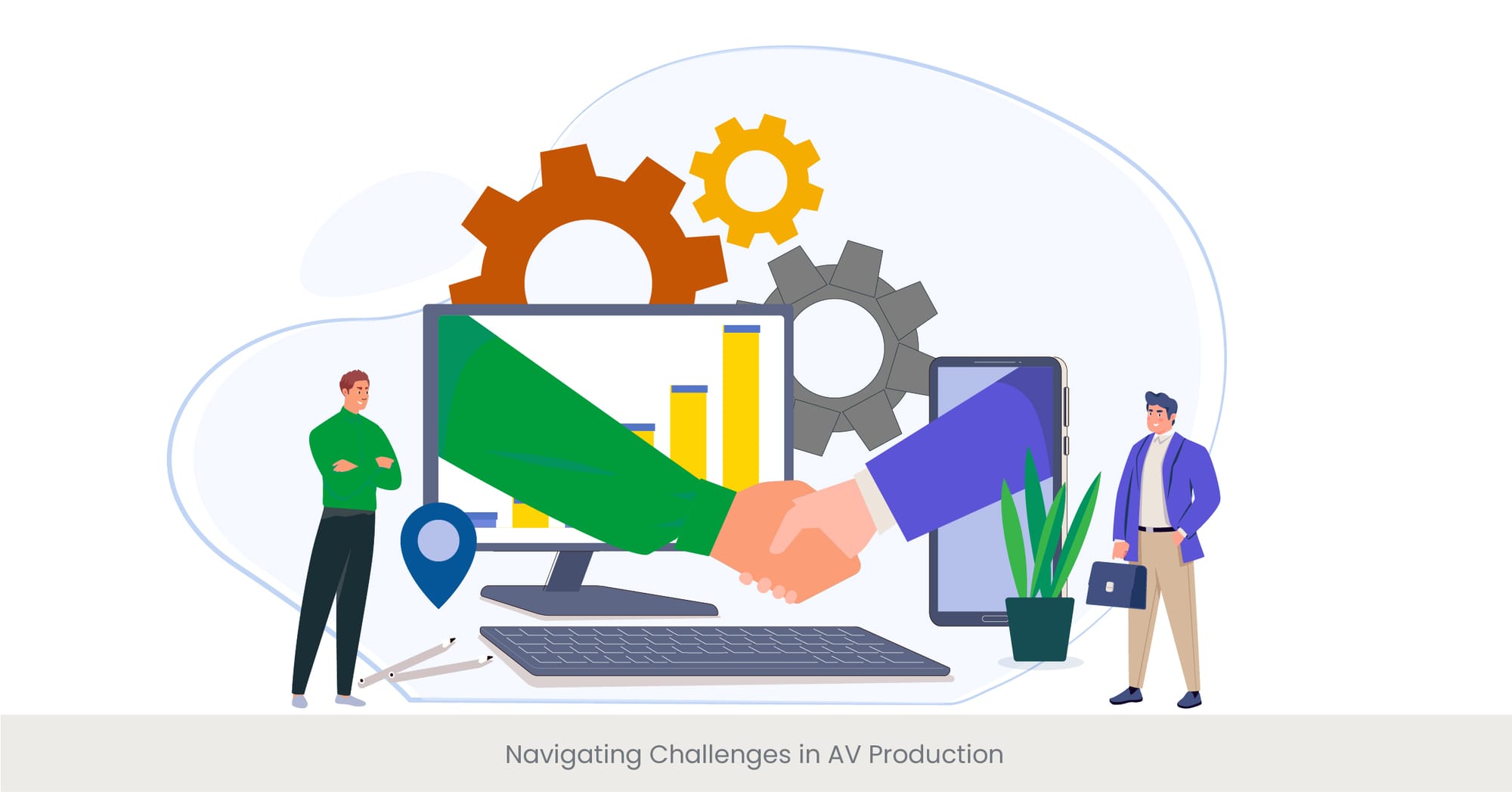
Introduction to Challenges in AV Production
Audio-visual (AV) production, whether for indoor or outdoor events, corporate meetings, or entertainment, involves a complex interplay of technology, logistics, and creativity. Each event presents its unique set of challenges, from technical difficulties to budget constraints and tight timelines. This section delves into the common hurdles faced in AV production and offers insights into effectively navigating these obstacles, ensuring a smooth and successful event.
The challenges in AV production can range from equipment compatibility issues and acoustical problems to unforeseen technical failures and resource limitations. Additionally, the rapid pace of technological advancements necessitates continuous learning and adaptation by AV professionals. By exploring the roots and nuances of these challenges, event organizers and AV companies can better prepare and implement proactive measures, minimizing disruptions and maximizing event impact.
Looking for more presentation tips and trends?
Explore Our Blog - 10 Steps to Mastering Your Product Launch Event Presentation
Real-World Solutions to AV Production Challenges
Overcoming the hurdles of AV production requires a blend of technical expertise, strategic planning, and flexibility. Case studies of successful events highlight how thorough pre-event testing, backup plans, and collaboration among all stakeholders can mitigate potential issues. For example, deploying experienced technicians for on-the-spot troubleshooting, utilizing versatile AV equipment that can adapt to different settings, and maintaining clear communication channels throughout all the equipment, event planning and execution phases are critical strategies. These practical solutions underscore the importance of preparedness and adaptability in the face of AV production challenges.
The strategies for navigating AV production challenges are further reinforced by industry research, expert opinions, and event feedback. Technical articles and guides published by AV associations provide actionable advice on anticipating and addressing common issues. Moreover, post-event analyses and reviews often shed light on the effectiveness of various problem-solving approaches, offering valuable lessons for future projects. By integrating these external insights, AV professionals and event organizers can enhance their strategies for overcoming challenges, ensuring the delivery of high-quality, engaging, and seamless events.
Innovations in Corporate Audio Visual Presentations
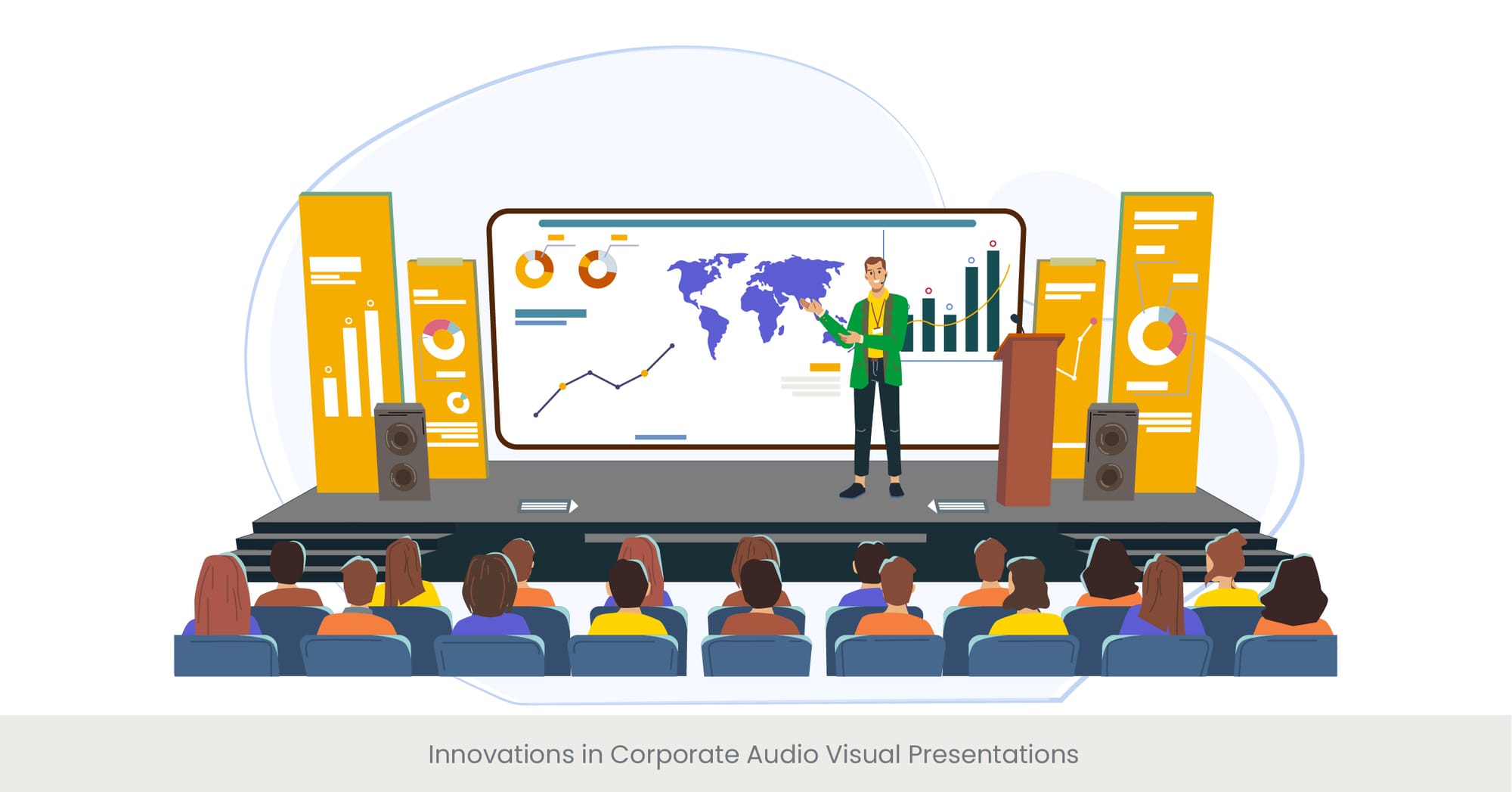
Introduction to Innovations in Corporate AV
In the corporate world, the impact of audio-visual (AV) presentations has been significantly amplified by technological innovations. Today's corporate AV presentations are not just about conveying information; they are about creating an immersive experience that captivates and engages the audience. This section explores the latest innovations in corporate AV presentations, highlighting how cutting-edge technology is being leveraged to enhance communication, collaboration, and engagement in the corporate setting.
Conference presentation designs have evolved significantly, with an increased focus on interactivity and dynamic visuals. Modern tools allow speakers to incorporate multimedia elements like videos, live polls, and interactive infographics. These features engage audiences, making the experience more impactful and ensuring information retention during corporate conferences and industry events.
The landscape of corporate AV presentations has evolved dramatically, driven by advancements in digital technology and a shift towards more interactive and engaging formats. From static slideshows to dynamic multimedia experiences, the integration of virtual reality (VR), augmented reality (AR), and interactive displays has transformed how information is presented and consumed in the corporate environment. Understanding this evolution is crucial for organizations looking to stay ahead in the increasingly competitive world of business communication.
Ready to elevate your presentation design?
Contact Us Now
Showcasing Innovations Through Real-World Examples
The transformative power of innovation in corporate AV presentations is best illustrated through real-world applications. Companies are now utilizing AR and VR to create immersive product demonstrations and virtual tours, offering a more interactive and engaging experience than traditional methods. Interactive touchscreens and digital whiteboards facilitate collaborative discussions and brainstorming sessions, enhancing teamwork and creativity. These examples demonstrate how innovative AV solutions can elevate corporate presentations, making them more effective and memorable.
The significance of innovations in corporate AV presentations is supported by industry research, expert analysis, and case studies. Studies published in business and technology journals highlight the positive impact of advanced AV solutions on audience engagement and message retention. Additionally, awards and recognitions for outstanding corporate AV projects provide tangible evidence of their effectiveness and innovation. By referencing these external sources, it's clear that investing in the latest AV technologies can significantly benefit corporate communication strategies.
Let’s make your ceremony unforgettable!
Inquire About Our Services
FAQs
What is an AV company?
An AV (audio-visual) company specializes in the provision of audio and video equipment, services, and solutions for a variety of events, meetings, and presentations. These companies offer comprehensive integration services, including the setup, operation, and maintenance of AV technology to enhance team communication and engagement in different settings.
What does the AV industry mean?
The AV industry encompasses businesses and professionals dedicated to the creation, management superior service, and deployment of audio and visual technologies. This includes everything from corporate audio-visual presentations, digital signage, and event production to installation services for audio-visual systems in various environments.
Who is the biggest AV company?
The biggest AV companies are those with extensive global networks, offering customers a wide range of services from event production to corporate AV solutions. While specific rankings can change, companies like AVI Systems and others are recognized for their large market presence, comprehensive service offerings, and innovative audio-visual solutions.
What does AV technology do?
AV technology facilitates the use of audio and video equipment to support communication, entertainment, and education. It includes the integration of various components such as speakers, microphones, projectors, and screens to create immersive audio-visual experiences for events, installations, and presentations.
What is an AV solution?
An AV solution refers to a customized set of audio-visual technologies and services designed to meet the specific needs of an event, meeting rooms, space, or organization. This can range from simple audio and video setups for small meetings to complex systems for large-scale events, incorporating digital signage, interactive displays, and more.
What does AV stand for in IT?
In the context of Information Technology (IT), AV stands for "Audio-Visual." It refers to the technologies and systems used to manage and distribute audio and video content, often integrating with IT infrastructure for streaming, audio video conferencing, and communication purposes.
What is an AV control system?
An AV control system is a centralized platform that manages and controls various audio-visual devices and functions within a space or a room at an event. These systems allow users to operate AV equipment, such as projectors, sound systems, and lighting, from a single interface, enhancing the ease and efficiency of AV management.
What does an AV company do?
An AV company provides services and solutions related to audio and visual technology, including consultation, design, installation, and maintenance of AV systems. They cater to a wide range of applications, from corporate events and educational settings to entertainment venues and other office and residential installations.
What is an audio-visual company?
An audio-visual company specializes in the supply and integration of AV technology, offering solutions that enhance communication and engagement through sound and visuals. These audio system and companies work across various sectors, providing equipment, expertise, and support for events, installations, and permanent setups.
What industry does audio-visual fall under?
The audio-visual industry falls under the broader technology and entertainment sectors, intersecting with IT, corporate communications, event planning, and media production. It plays a crucial role in facilitating effective communication and immersive experiences in both professional and leisure contexts.



%20(1).jpg)
%20(1).jpg)


